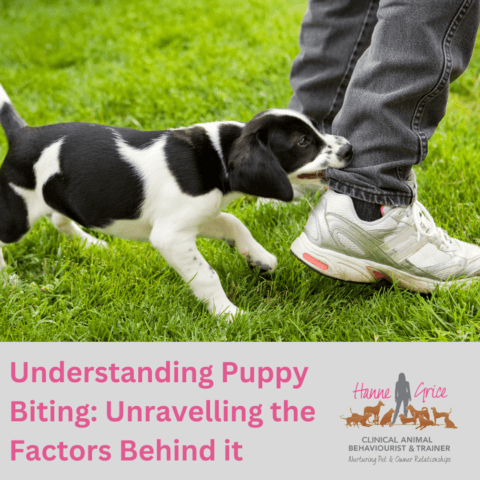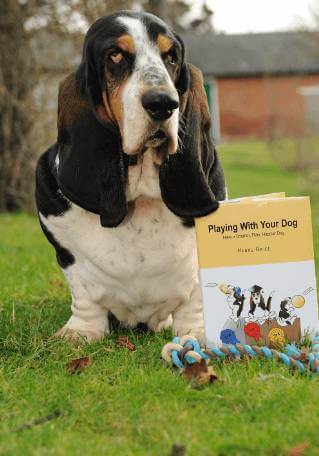Bringing a new puppy home is an exciting and joyous experience. However, as you embark on this journey, it’s essential to understand that puppies, like human babies, go through various developmental stages. One common behaviour that many new puppy owners encounter is biting. While puppy biting can be frustrating, it’s crucial to recognise that there are several contributory factors at play. By understanding the different causes for puppy biting and what to rule in and out (referred to diagnostic differentials), you can address these factors effectively and reduce biting behaviour. To get videos on how to reduce biting, handling exercises and much more – check out my Puppy Package – a one-stop shop for all new puppy owners.
Let’s explore the various reasons behind puppy biting and how to tackle them.
The table below highlights the varied causes that can lead to puppies biting to provide a quick overview for owners. This table is by no means an exhaustive list; however, it aims to help owners understand the varied possible causes, so they can then ‘rolodex’ their way through the differentials to rule out and rule in likely causes and address them.
| Behavioural Diagnosis | Description | References |
| Normal Puppy Behaviour Solicitation of play | Age-appropriate exploration and play biting Pups will also mouth, jump, grab and bite to initiate some sort of interaction such as play | Coren, S. (2007). How to Speak Dog: Mastering the Art of Dog-Human Communication. |
| Teething | Biting due to discomfort from teething (typically from 12-18 weeks and again around 6-10 months) | American Kennel Club. (n.d.). Teething in Puppies: What to Expect. |
| Fear or Anxiety | Biting as a response to fear or anxiety (e.g. overwhelmed by the handling of a well-meaning visitor, or being shouted at by the owner) | Overall, K. L. (2013). Manual of Clinical Behavioral Medicine for Dogs and Cats. |
| Lack of Bite Inhibition | Insufficient training in controlling the force of biting | McConnell, P. (2002). The Cautious Canine-How to Help Dogs Conquer Their Fears. |
| Socialisation Issues | Inadequate calm, positive and gradual exposure to other dogs and people | Dunbar, I. (2004). Before and After Getting Your Puppy: The Positive Approach to Raising a Happy, Healthy, and Well-Behaved Dog. |
| Resource Guarding | Biting to protect valuable resources (e.g. where the pup has experienced owners chasing after them and grabbing items off them, causing an escalation in the dog’s behaviour) | Miller, P. (2014). Mine! A Practical Guide to Resource Guarding in Dogs. |
| Pain or Discomfort | Biting due to underlying pain or discomfort (e.g. ear mites, gut issues, allergies and more) | Yin, S. (2009). Low-Stress Handling, Restraint and Behavior Modification of Dogs and Cats. |
| Predatory Behaviour | Biting as a result of natural prey drive | Mech, L. D. (2003). Wolves: Behavior, Ecology, and Conservation. |
| Frustration | Biting directed towards a different target due to frustration (e.g. pup is on-lead and sees another dog and cannot get to them so may start biting the lead, jumping up and the owner and even directing onto the owner) | Landsberg, G. M., Hunthausen, W. L., & Ackerman, L. J. (2012). Behavior Problems of the Dog and Cat. |
| Medical Conditions | Biting as a symptom of an underlying medical issue – similar to pain and discomfort, prompting the biting behaviour | Landsberg, G. M., & Horwitz, D. F. (2005). Handbook of Behavior Problems of the Dog and Cat. |

- Normal Puppy Behaviour: Puppies explore the world with their mouths, just as human babies do with their hands. Nipping, mouthing, and play biting are typical behaviours as they learn about their environment, whether they can eat something or not, understand its smell, and interact with their littermates and humans. It’s essential to distinguish between normal puppy play biting and aggressive behaviour.
- Teething: Similar to human infants, puppies experience discomfort during the teething process. Biting and chewing help alleviate the pain and facilitate the shedding of their baby teeth. Provide appropriate teething toys and supervise their chewing activities to redirect their biting behaviour.
- Fear, frustration or Anxiety: Puppies may resort to biting when they feel fearful, frustrated or anxious. It could be due to unfamiliar situations, loud noises, past negative experiences, or factors such as hunger, thirst, too hot/cold, bored, having excess energy, being overwhelmed by well-meaning friends/neighbours/family attempting to play/pet for too long/too roughly and so on. Patience, positive reinforcement, and gradual exposure to new environments, people, animals and situations, can help alleviate their fear. Being mindful of the puppy’s feeding/play/exercise schedules, providing plenty of enrichment opportunities and appropiate things puppy can direct their biting onto is critical.
- Lack of Bite Inhibition: Puppies need to learn bite inhibition, which refers to controlling the force of their bites. Littermates and their mother teach them this important skill during early socialization. However, if a puppy hasn’t had sufficient exposure to proper bite inhibition, they may bite too hard during play. Gentle training techniques and discouraging rough play can help address this issue. Practice Consent Testing to give your puppy choice over their interactions, and to help you learn their subtle body language signs about what they like and don’t like when it comes to being touched.
- Socialisation Issues: Insufficient socialisation with other dogs and people can contribute to biting behaviour. Proper socialisation, exposing your puppy to a variety of positive experiences, can help them develop confidence and reduce fear-based biting. Check out my Puppy Socialisation Bingo Game Card to help with this.
- Resource Guarding: Puppies may bite to protect their valuable resources, such as food, toys, or sleeping areas. Early training and teaching them to associate positive experiences with resource sharing can prevent resource guarding behaviour. Never shout, hit, or chase after your puppy if they take something – management of the puppy’s environment is critical to reduce access to anything you’d rather your puppy didn’t get to, and providing them with alternatives and trading when they have something that could be potentially dangerous is important to reduce escalations which can be more problematic as the puppy enters adolescence (from around 6 months of age).
- Pain or Discomfort and Medical Conditions: Biting can be a sign of underlying pain or discomfort. Dental issues such as teeth pain/inflamed gums, headaches/ear ache and upset tummies caused by teething, injuries, gut problems such as parasites/intolerances, compacted anal glands, ear mites, itchy skin, painful hips/knees, and other medical conditions are just some of the many reasons a puppy may jump up and grab, especially when being touched if this causes them to feel uncomfortable. Regular veterinary check-ups, owner health checks and grooming, and addressing any health concerns promptly can help mitigate biting due to pain. If you notice sudden changes in behaviour or biting out of character, consult your veterinarian to rule out any medical causes.
- Predatory Behaviour: Puppies, particularly those from working or herding breeds, may exhibit biting behaviour rooted in their natural prey drive. Understanding their breed tendencies and redirecting their instinctual behaviour through appropriate training can help manage this issue. By engaging the support of a rigorously assessed and certified trainer or behaviourist, can help owners with such matters – check out the Animal Behaviour and Training Council’s Practitioner Directory for a list of practitioners located near you.
- Frustration: Puppies, just like young humans, are not born with patience and the ability to control their emotions. They can get easily frustrated; this can lead to the puppy redirecting their frustration towards a different target like the owner’s hands, feet or bottom! For example, when puppies are small, owners may frequently pick them up off the sofa that they are trying to jump on, grab them away from young children if the puppy is jumping up, or pushing them into a crate to enforce rest. However, such handling can startle and frustrate, prompting a bite. Instead, teach your puppy to come when called when you see them heading for the sofa – redirecting away and rewarding positive behaviours reduces the problem and increases the chances for puppy to learn what you want them to do. Make sure you have great management – reduce access to any people your puppy is targeting when fully awake/alert (such as having a puppy on their harness and a house line, and reward for all four paws on the floor), or remove access to areas you do not want them to jump at (think dog gates/room dividers and so on). Overstimulation is another common cause for a pup to get frustrated, as mentioned previously, where owners may play for too long or roughly. Overtiredness can lead to overwhelm where a puppy may have their sleep disturbed/interrupted by their surroundings, such as sudden loud sounds, or well-meaning friends or children wanting to interact with the puppy when the puppy is tired, and so on. It’s essential to recognise signs of overstimulation and provide appropriate outlets for their energy, such as exercise and mental stimulation that is appropiate to the puppy’s age, breed needs, and state of health. Do ensure your puppy gets plenty of rest and quality sleep.
Understanding the diagnostic differentials for puppy biting is vital for new puppy owners. By recognising the various contributing factors, you can address them effectively and create a safe and harmonious environment for your new furry friend. Remember, patience, consistent training, positive reinforcement, and seeking professional guidance when needed are key to managing and reducing biting behaviour in puppies.
References:
- Coren, S. (2007). How to Speak Dog: Mastering the Art of Dog-Human Communication.
- American Kennel Club. (n.d.). Teething in Puppies: What to Expect.
- Overall, K. L. (2013). Manual of Clinical Behavioral Medicine for Dogs and Cats.
- McConnell, P. (2002). The Cautious Canine-How to Help Dogs Conquer Their Fears.
- Dunbar, I. (2004). Before and After Getting Your Puppy: The Positive Approach to Raising a Happy, Healthy, and Well-Behaved Dog.
- Miller, P. (2014). Mine! A Practical Guide to Resource Guarding in Dogs.
- Yin, S. (2009). Low-Stress Handling, Restraint and Behavior Modification of Dogs and Cats.
- Mech, L. D. (2003). Wolves: Behavior, Ecology, and Conservation.
- Landsberg, G. M., Hunthausen, W. L., & Ackerman, L. J. (2012). Behavior Problems of the Dog and Cat.
- Landsberg, G. M., & Horwitz, D. F. (2005). Handbook of Behavior Problems of the Dog and Cat.
Learn more about our classes

Get Hanne's book, clothing and more
Hanne has a number of publications including her book Playing With Your Dog to help owners work out the games that are best suited for their pet to play throughout his life, from puppyhood to old age, available from Amazon. Check out Hanne's range of contemporary casuals The Collection – for pet lovers made from recyclable, organic materials that are sustainably sourced.


